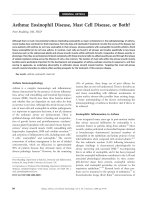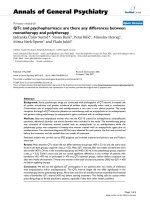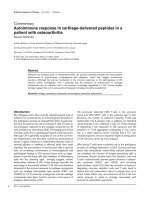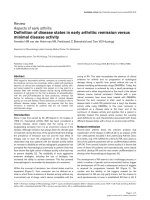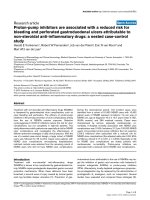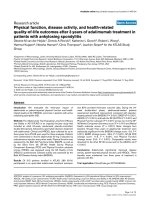Báo cáo y học: "Autoimmune liver disease - are there spectra that we do not know" pot
Bạn đang xem bản rút gọn của tài liệu. Xem và tải ngay bản đầy đủ của tài liệu tại đây (326.35 KB, 7 trang )
CAS E REP O R T Open Access
Autoimmune liver disease - are there spectra that
we do not know?
Hind I Fallatah and Hisham O Akbar
*
Abstract
Autoimmune liver diseases (AILDs) are common leading causes for liver cirrhosis and terminal stage of liver disease.
They have variable prevalence among patients with liver disease and have two major clinical and biochemical
presentations. Autoimmune hepatitis (AIH) is the typical example of hepatocellular AILD, but it can also be
presented under a cholestatic pattern. AIH has a scoring diagnostic system and respond in most cases to the
treatment with prednisolone and azathioprine. Primary biliary cirrhosis (PBC) is the second most common AILD,
with a cholestatic presentation and characterized by positive antimitochondrial antibody (AMA). It has an excellent
response and long term outcome with the administration of ursodeoxycholic acid (UDCA). Another AILD that is
thought to be a variant of PBC is the autoimmune cholangitis, being a disease that has biochemical and
histological features similar to PBC; but the AMA is negative. Primary sclerosing cholangitis (PSC) is a rare entity of
AILD that has a cholestatic presentation and respond poorly to the treatment, with the ultimate progression to
advance liver cirrhosis in most patients. Other forms of AILD include the overlap syndromes (OS), which are
diseases with mixed immunological and histological patterns of two AILD; the most commonly recognized one is
AIH-PBC overlap (AIH-PSC overlap is less common). The treatment of OS involves the trial of UDCA and different
immunosuppressants. Here we present three case reports of unusual forms of chronic liver diseases that most likely
represent AILD. The first two patients had a cholestatic picture, whereas the third one had a hepatocellular picture
at presentation. We discussed their biochemical, immunological and histological features as well as their response
to treatment and their outcomes. Then, we compared them with other forms of AILD.
Keywords: Autoimmune liver disease, autoimmune hepatitis, primary biliary cirrhosis, primary sclerosing cholangitis,
autoimmune cholangitis, cholestasis, hepatocellular, ursodeoxycholic acid
Background
Autoimmune liver diseases (AILD) are a group of immu-
nologically induced hepatic damage that are either hepato-
cellular or cholestatic [1,2]. The hepatocellular forms are
characterized by a significant elevation of the serum
alanine aminotransferase (ALT) and aspartate aminotrans-
ferase (AST), as compared with the biliary enzymes,
together with elevated serum b ilirubin. The cholestatic
forms involve either the intra- or the extra-hepatic biliary
systems or both. Cholestasis will ultimately cause impair-
ment of bile formation and/or bile flow which may clini-
cally present with fatigue, pruritus, and jaundice [1,2]. The
biochemical markers include increases in serum alkaline
phosphatase (ALP) and gamma-glutamyl transpeptidase
(GGT), followed by conjugated hyperbilirubinemia, at
more advanced stages. Cholestasis is considered chronic if
it lasts more than 6 months [3]. Most chronic cholestatic
diseases are purely intra-hepatic [3,4]. They are considered
as different disease entities based on the clinical, labora-
tory and histological features [3,4]. In many instances,
however, some of the histological and or the pathological
features of one AILD disease may follow another; in addi-
tion, t he two disease entities may coexist in the same
patient [3,4]. Tho se forms of presentations are defined as
overlap syndromes (OS) [3,4]. The presence of the overlap
patterns of cholestatic liver disease suggests that those dis-
eases may represent spectra of a common or similar
immunological and pathological process tha t causes the
hepatobiliary damage [1,5].
Autoimmune hepatitis (AIH) is a chronic relapsing
remitting necroinfl ammatory disease associated with ele-
vation of the serum immunoglobulins and autoantidobies
* Correspondence:
King Abdul Aziz University Hospital, Jeddah, Saudi Arabia
Fallatah and Akbar Comparative Hepatology 2011, 10:9
/>© 2011 Fallatah and Ak bar; licensee BioMed Cen tral Ltd. This is an Open Access article distributed under the terms of the Creative
Commons Attribution License ( which permits unrestricted use, distribution, and
reproduction in any medium, provided the origina l work is properly cited.
[2,6]. The disease mostly affects children and young
adults, but can also affect older people [7-9]. AIH has
various clinical presentations from asymptomati c d isease
to advance liver cirrhosis or severe forms of acute liver
failure [6-9]. The usual biochemical presentation of AIH
is a hepatocellular pattern (more prominent elevation of
the serum ALT and AST as compared to serum ALP and
GGT), but in many cases AIH can present with a chole-
static picture that may confuse AIH with other autoim-
mune cholestatic liver diseases [6,9-12]. The diagnosis
of AIH is based on the scoring system that was estab-
lished and modified by the International Autoimmune
Hepatitis Group [13,14]. Simplified diagnostic scoring
criteria have been suggested [15]. The treatment of
choice for AIH is corticosteroids and azathioprine. The
maj ority of treated patients with AIH will achieve remis-
sion with this therapy; in some reports, 65% and 80%
at 18 month and 3 years, respectively [2,16,17]. In the
remaining 20% - standard therapy unresponsive AIH -
other form of immunosuppressant medication have been
tried, like mycophenolate mofetil, and cyclosporine, and
found to be effective in some patients [2,16].
Primary bili ary cirrhosis (PBC) is a non-suppurative
destructive granulomatous cholangitis characterized by
involvement of the small intra-hepatic bile du cts [2,4,18].
PBC mostly affect middle-aged females. Many patients
with PBC are asymptomatic whereas others may complain
of fatigue and pruritus. The liver biochemical parameters
will show cholestatic abnormality of the hepatic enzymes.
The serum immunoglobulin profile will show elevated
serum IgM [18,19]. Positive serum antimitochondrial anti-
bodies (AMA) are the characteristic hallmark for PBC it is
found in 90-95% of patients [2-4,18]. In the diagnosis of
PBC, liver biopsy is not mandatory in the presence of cho-
lestatic pattern of liver enzymes and positive serum AMA;
but it may help in staging the disease [3,18]. The treatment
of choice for patients with PBC is ursodeoxycholic acid
(UDCA). It has been found in several studies that UDCA,
at a dose of 13-15 mg/kg/day, is effective in improving the
liver biochemistry, and delay the histologi cal prog ression
of the disease. It was also found to be effective in the
improvement of survival and reduce the need for liver
transplantation [2,3,18]. UDCA is not effective for reliev-
ing the pruritus in PBC – other agents, like cholestyramine
and rifampicin, are used for the purpose. Several other
medications (including cyclosporine, corticosteroids,
azathioprine, thalidomide, m ycophenolate mofetil, chlor-
ambucil, penicillamine, methotrexate, and colchicine) have
been tried in patients w ho had inadequate response t o
UDCA, but none of them showed promising effects
[2,3,18], apart from budesonide combined with UDCA in
an early stage of the disease [20].
Autoimmune cholangitis (AIC) - o r antimitochondrial
antibody-negative primary biliary cirrhosis (AMA
negative PBC) - is an autoimmune cholestatic liver
disease that was described in 1987. Over the following
years, an increasing number of pati ents with similar p re-
sentations have been observed [4]. AIC has distinctive
features from PBC in that the AMA is negative, the
serum IgM is normal, whereas showing a higher fre-
quency of positive in antinuclear antibodies (ANA) and
smooth mu scle antibodies (SMA ) [4,21]. The subsequent
identification of more cases of AIC that mimicked PBC
raised the possibility that AIC may be a transitional stage
of PBC [22,23]. In some patients who had PBC, the
detectionofAMAmaybeafalsenegativeiflowersensi-
tivity assays are used and those patients will be misdiag-
nosed as AIC [24]. Earlier reports on the treatment of
AIC had shown poor response to the treatment both to
corticosteroids and UDCA [23]. However, in a recent
study, it was shown that AIC patients had a similar
response rate to that of patients with AMA plus PBC
[25].
Primary sclerosing cholangitis (PSC) is a chronic, pro-
gressive cholestatic liver disease of unknown etiology,
characterized by an inflammatory and fibrotic structuring
process affecting both intra- and extra-hepatic bile ducts.
It is a disease that is more common in men at their 40s,
with a male:female ratio of 2:1 [2,3,26]. In 80% of patients
PSC is associated with inflammatory bowel disease, mor e
commonly with ulcerative colitis. The diagnosis of PSC is
made in the presence of a cholestatic biochemical profile
and the typical cholangiographic findings of multifocal
strictures and segmental dilatations, and secondary bile
ducts changes on magnet ic resonance cholangiography
(MRCP), endoscopicretrograde cholangiography or percu-
taneous transhepatic cholangiography. The causes of
secondary sclerosing cholangitis have to be excluded
[4,26]. Elevated serum IgG and positive autoantibodies are
other features for PSC. The most frequently encount ered
autoantibody in PSC is the antineutrophil cytoplasmic
antibodies (ANCA), in 26-94% of PSC patients. Although
not specific, the liver biopsy finding may help to support
the diagnostic [4,26]. Patients who had biochemical,
immunological and histological features for PSC, but
normal cholangiographic examination, are classified as
small duct PSC [26,27]. Although less promising in PSC
compared to PBC, UDCA is the only medication to date
found to be effective in PSC patients. It w as shown that
UDCA results in biochemical improvement [28]. Histolo-
gical improvement of PSC on the treatment with UDCA
has been demonstrated too [29]. In PSC patients who had
dominant structure with severe biochemical deterioration,
or recurrent septic cholangitis, percutaneous or endo-
scopic cholangiographic approaches can be used to relieve
the obstruction [4,26].
The autoimmune overlap syndromes (AOS) are sup-
posed to arise as distinctive cholestatic liver diseases or
Fallatah and Akbar Comparative Hepatology 2011, 10:9
/>Page 2 of 7
an outcome of two coexisting AILDs [4]. AOS account
for 1 3.9-18% of all patients with AILDs [30,31]. The
pathogenesis of the AOS is not clear [32]. AIH-PBC over-
lap is the most common form [32]. They are thought to
arise from AIH and PBC developing simultaneously or
one preceding the other [33]. Diagnostic scoring criteria
for AIH-PBC have been developed [34] and recently a
simplified diagnostic score have been suggested [35].
AIH-PSC overlap is a disorder with ill-defined immune
mediated backgrounds [3]. It is more common in children
and adolescent [3,32]. Although no specific diagnostic
criteria have been established for AIH-PSC overlap, in the
largest reported number of patients with this syndrome –
they had clinical, biochemical and immunological features
of AIH coexisting with radiological evidence of PS C [36].
The treatments of AOS are empiric and involve the use of
both immune suppressive therapy and UDCA [3,30,32,37].
Patients with AIH-PBC overlap have treatment response
and prognostic outcome that is poorer compared with
those with isolated AIH and BPC; but patients with AIH-
PSC overlap have treatment response and prognosis that
have worse prognosis when compared to patients only
with AIH and otherwise better when compared to patients
only with PSC [37,38].
Case presentations
First patient
A 27-year-old Chadian lady, mother for 2 children, had a
history of progressive jaundice and itching for 2 years. She
denied the ingestion of medication and herbal medi cines,
previous similar attacks, jaundice during pregnancy, con-
tact with jaundice patient and blood transfusion. She also
denied a family history of liver disease or similar presenta-
tions. On physical examination, she was slim (weight:
36 kg) with stable vital sig ns. Examination was only posi-
tive for deep jaundice and scratch marks all over the body;
the rest of the examination was unremarkable. The lab
tests showed normal CBC apart from mild anemia; hemo-
globin of 11.3 g/dl, white blood cells (WBC) 5.9 k/μland
platelets (Plat) of 190 k/μl. The prothrombin time (PT) of
15 seconds was normal (11-14).
The liver function tests showed ALT 40 U/L (normal
30-65), AST 74 U/L (normal 15-37), ALP 231 U/L (normal
50-136), GGT 321 U/L (normal 5-85), total protein 60 g/L
(normal 64-82), albumin 25 g/L (normal 35-50), and total
and direct bilirubin 325 μmol/L (normal 0-17) and
274 μmol/L (0-5), respectively.
She had negative immunolog ical profile for ANA done
by indirect immunofluorescence (IIF), SMA done by
ELISA, ANCA done by IIF, liver kidney microsomal-1
(LKM-1) done by ELISA, as well as negative serology for
hepatitis B virus (HBSAg, HBeAg, HBeAb, HBcAb),
hepatitis C virus (HCVAb) and HIV. The serum immu-
noglobulin-G (IgG) level was 23 (normal 5.4-16.1). The
serum copper, ceruloplasmin, 24 hour urine copper,
serum iron and transferr in saturation were all normal.
Ultrasound abdomen and MRCP were normal. Liver
biopsy sh owed evidence of interphase hepatitis stage 3/6,
with focal intrabiliary steatosis and mild intra cellular
cholestasis. The histological activity index was 5/18.
She started treatment with prednisolone (60 mg daily)
and UDCA (250 daily); nevertheless, for over 6 month
she did not show a ny improvement of the symptoms or
liver enzymes profile (maintaining normal to 1.5 times
normal ALT and AST) but continued to have progressive
cholestasis (Figure 1). Over the next 6 months of follow
up, the symptomatology worsed. She developed moderate
ascites that progressed to diuretic refractory ascites over
a few months, recurrent bacterial peritonitis and 4
attacks of stage III-IV hepatic encephalopathy. Predniso-
lone was t apered down, and then stopped; finally, she
was selected for liver transplantation, however she died
while in the waiting list.
Second patient
The second patient was a 30-year-old male, a Saudi
security officer, who presented a history of progressive
jaundice for 2 years. He had unremarkable past history,
denying drug or alcohol abuse, and medications, includ-
ing herbal medicines. There was no family history of
liver disease or history of contact with jaundiced
patients. His physical examination showed normal vital
signs. He had deep jaundice, but the rest of the general
examination was normal. The chest, the cardiovascular,
and the abdominal examinations were normal. His base-
lineworkupshowedCBC(WBC8.4k/μl, Hg11.5 g/l,
Plat 373), LFT (AST 531 U/L, ALT 250 U/L, ALP 682
U/L, GGT 205 U/L, TBil 344, Direct Bil 278, albumin
Figure 1 Results of the serum alkaline phospha tase (Alk phos)
and bilirubin levels (T Bil) for the first two patients during the
follow-up.
Fallatah and Akbar Comparative Hepatology 2011, 10:9
/>Page 3 of 7
17, total protein 80), PT 13.3, and the renal functions
were normal. The ultrasound examination of the abdo-
men showed hepatomegaly, but there were no evidence
of biliary obstruction.
The ANA, SMA, AMA, LKM-1, HBV serology, HCV
serology and the HIV testing were all negative. The serum
IgG level was 25. Testing for Wilson’s disease, by serum
copper, ceruloplasmin and 24 hours urine copper, revealed
normal results. Similarly, the serum iron and the total iron
binding capacity (T IBC) and the transferrin saturation
were normal. He had MRCP that showed a normal biliary
system cholangiography. A liver biopsy was performed
and it detected marked sinusoidal dilatation, infiltration of
the biliary tracts with chronic inf lammatory cells (mostly
lymphocytes and some plasma cells), associated with bile
duct damage. There was also chronic inflammatory cell
infiltration of the hepatic lobules. The hepatocytes showed
cholestasis. In some areas some of the hepatocytes w ere
replaced by macrophages. There was also a mild portal
and sinusoidal fibrosis.
He was given a trail of prednisolone (40 mg, daily) and
UDCA (250 mg, three times a day), but excessive acne and
skin rash appeared. Prednisolone was reduced t o 30 mg
and azathioprine (50 mg, daily) was started then gradually
increased (to100 mg, daily). The treatment was maintained
for more than 8 months; however, he had only transient
improvement in the liver enzymes and bilirubin levels in
the first few weeks of the treatment; nonetheless, latter on
he lost that response while still on prednisolone and
azathioprine. The ser um ALT and AST were maintained
at the 3-4 times above the normal, but the ALP and biliru-
bun progressively increased ( Figure 1); so prednisolone
and azathioprine were discontinued. Because of s evere
symptomatic cholestasis, he was selected for liver
transplantation.
Third patient
The third patient was a 36-year-old Indian male who had
progressive jaundice and itching for 10 month. He also
noticed darkening of the urine and he also complained of
intermittent melena, alternating with fresh rectal bleeding,
over the past few months. Six month later, he had right
upper quadrant abdominal pain of moderate severity. Two
month prior to his clinical appointment, he start having
progressive abdominal distention, and lower limb edema,
for which he was given diuretics in a polyclinic; the ascites
had improved. He did not have history of fever or hepatic
encephalopath y during that period. There was no history
of medication or herbs intake, drug or alcohol abuse,
contact with jaundiced patients and family history of liver
disease. His general examination was remarkable for jaun-
dice, palmar erythema, spider nevi, itching marks and mild
lower limb edema. The chest examination revealed right-
sided pleural effusion. The cardiovascular examination
depicted a short systolic murmur. On the abdominal
examination, he had a moderate amount of ascites and
splenomegaly. The lab data showed: CBC (WBC 3.82 k/μl,
Hg12.7 g/dl, Plat 106 k/μl), PT 17.9 seconds, LFT(AST
223 U/L, ALT 74 U/L, ALP 174 U/L, GGT 215 U/L, TBil
144 μmol/L, DBil 12 μmol/L, albumin 22 g/L, TP 66 g/L),
the renal functions were normal. The immunological pro-
file was negative for ANA, LKM-1, AMA, ANCA, HBV,
HCV and HIV. The SMA was weakly positive. The serum
IgG was elevated 26.6 g/L and the serum IgM was normal.
Tests for Wilson’s disease, by serum and urine copper stu-
dies, and by ceruloplasmin testing, were normal. Similarly,
the serum iron, transferrin, TIBC and tran sferrin satura-
tion were also normal. The level of alpha-1 antitrypsin was
also normal. The ultrasound examination of the abdomen
showed hepatosplenomegaly and moderate amount of
ascites. The echocardiogram was normal. Upper gastroin-
testinal endoscopy showed grad III esophageal varices.
Endoscopic examination of the colon revealed internal
piles, but the colonic mucosa was normal. Because of the
clinical and laboratory evidence of advanced cirrhosis, the
liver biopsy was deferred. He was thought to have late
stage of AIH and was given a trial of prednisolone (30 mg,
daily). Over the following 3 month of treatment, he had
neither clinical nor biochemical improvements. His liver
function tests at the end of the 3 month of the treatment
with prednisolone showed ALT 247 U/L, AST 181 U/L,
ALP 174 U/L GGT 167 U/L and tota l Bil 98 μmol/L. He
was advised to undergo liver transplantation; therefore, he
traveled back to India to have it done there.
Discussion
The above thr ee patients had atypical forms of chronic
liver disease that lead to decompensated advanced cirrho-
sis in two o f them. The immunological profile and the
serum antibodies testing were performed for all of them in
different medical centers, on at least two occasions, and
the same above result was obtained. The first patient was
a young female who started to have jaundice at the age of
25 years. With the negative viral profiles and the negative
workup for metabolic diseases she was thought to have an
atypical presentation of AIH, because of the cholestatic
liver enzyme profile and negative autoantibodies. However,
the elevated serum IgG of 1.43 times the upper normal
and the liver biopsy features supported the possibility of
AIH. In the most recent simplified criteria for the diagno-
sis of AIH, serum IgG of 1.1 times the normal is accepted
in the diagnosis of AIH and a level of 1.44 the normal was
found to be the best diagnostic predictor for AIH [15].
AIH with negative autoanti bodies is not unusual [13,39].
The treatment response of this form of AIH compared to
autoantibodies positive AIH have not been previously
addressed. AIH usually respond partially, or even comple-
tely, to the treatment with steroids and azathioprine
Fallatah and Akbar Comparative Hepatology 2011, 10:9
/>Page 4 of 7
[2,16]. The absence of response to prednisolone in this
patient even after increasing of the dose to 2 mg/kg
sounds against AIH. Because o f the cholestatic presenta-
tion AIC (AMA negative PBC) was another possibility;
but, once again, in the previously reported cases of AIC
autoantibodies were part o f the diagnostic features. In
addition, AIC have been found to respond to the treat-
ment with steroids, azathioprine and UDCA [23,25]. This
was not the case in this patient. On the other hand, the
rapid progression to cirrho sis in relatively short time in
spite of the treatment with UDCA sounds against AIC.
PSC was almost ruled out by negative cholangiography
and absent histological feature for PSC.
The second patient was a young male who had a similar
presentation to the first patient. Because of elevated serum
IgG and liver biopsy features, AIH was also considered the
most likely diagnosis. AIH i s more common in females
but it is a disease that have been frequently reported in
malesaswell[7,9,10].ThediagnosisofAIHwasfurther
supported by th e trans ient partial response to predniso-
lon e and azathioprine in the first few weeks of the treat-
ment. AIC (AMA negative PBC) was another possi bility
that was considered. It has been shown in the previous
reports on AIC that it is less responsive to the treatment
as compared to AIH [23,40]. Being a male with atypical
histological features and absence of response to UDCA
make AIC unlikel y. Similar to the first patient, PSC w as
ruled out because of absent cholangiographic and histolo-
gical features which could support it. Because he had
intractable symptoms with severe cholestasis he was
selected to liver transplantation [3,40].
The third patient had hepa tocellular elevation of the
liver enzymes. This, together with high serum IgG level
and weakly positive SMA, raises the possibility of AIH in
this patient. The liver biopsy was not performed because
of the advance stage of the disease. Upon his presentation
this patient had already evidence of advanced de-compen-
sated cirrhosis. This may be the reason for his poor
response to the treatment. In the previous reports on AIH
patients with de-compensated cirrhosis although they have
less chance of response to the treatm ent as compar ed to
compensated patients they can still have complete or near
complete response with favorable outcome [7,9]. Because
of the hepatocellular presentation, PBC, AIC and PSC
were not likely to be the diagnosis in this patient.
AOS of autoimmune liver disease were unlikely to be
the diagnosis in the three patients, because of the absent
typical immunological and biochemical features of both
types o f AOS. Some of the non-autoimmune chronic
liver diseases have been reported to be associated wi th
elevated serum immunoglobulins and variable levels of
positive autoantibodies [41,42]. Drug induced liver dis-
ease or toxic hepatitis can cause both cholestatic or hepa-
tocellular hepatic abnormalities [43,44], but these have
been ruled out by the detailed frequent questioning o f
the three patients. Another issue regarding toxic hepatitis
is that most injures are of acute forms, and only few
medications (like miodarone and methotrexate) have
been reported to cause liver fibrosis and cirrhosis [45,46].
Familial forms of intra-hepatic inherited cholestatic syn-
dromes were unlikely in the first and the second patient,
because of the age of presentation, and because both of
them had negative family history of liver disease [3].
Non-alcoholic fatty liver disease was not a possibility
because of the young age of the three patients, short time
or progression to cir rhosis and presence of cholestatic
picture in the first two patients sounds against crypto-
genic cirrhosis [47]. On the other hand, cryptogenic cir-
rhosis was reported to be associated with diabetes
mellitus, hyperlipidemia and high body mass index,
which was not the case in all the three patients [47].
Conclusions
In many instances autoimmune liver diseases have been
thought to represent spectr a or variable presentation of
similar disease entity [3]. Although the immunological
features in the three patients we studied were not so
strong, the possibility that they had a form or forms of
autoimmune liver disease that is not responding to the
usual immunosuppressants and that progress rapidly to
advanced cirrhosis at relatively young age is there.
Future reporting of similar cases and trails of immune
suppressants other than prednisolone and azathioprine
in such patients may help to identify an effective treat-
ment of such patients avoiding them the need of liver
transplantation.
Consent
Written informed consent was obtained from for the pub-
lication of these Case Reports. Consent was directly made
by the patients in t he cases of the second and third
patients. Respecting the first patient, the consent was
obtained from her sister, with the family agreement.
Copies of the written consent documents are available for
review by the Editor-in-Chief of this journal, and they may
be requested to the authors at any time.
Authors’ contributions
Both HIF and HOA participated in the clinical follow up, in the management
of the three patients, in the literature review, and in the writing and editing
of the manuscript. All authors read and approved the final content of the
manuscript.
Authors’ information
HIF: Dr Hisham O Akbar MBCh B, FRCPCanada, Associate Professor,
Consultant Gastroenterologist and Hepatologist, Director of the
Gastroenterology and Hepatology Section, King Abdul Aziz University
Hospital, Jeddah, Saudi Arabia, member of the Saudi Gastroenterology
Association, member of the Saudi Association for Internal Medicine, member
of the APASL.
Fallatah and Akbar Comparative Hepatology 2011, 10:9
/>Page 5 of 7
HOA: Dr Hind I Fallatah, MBCh B, Arab Board and Saudi Board of Internal
Medicine, MACP. Consultant Gastroenterologist and Hepatologist, King Abdul
Aziz University Hospital, Jeddah Saudi Arabia, member of the Saudi
Gastroenterology Association, member of the Saudi Association for Internal
medicine, Member of the APASL.
Competing interests
The authors declare that they have no competing interest s.
Received: 29 May 2010 Accepted: 12 September 2011
Published: 12 September 2011
References
1. Kumagi T, Alswat K, Hirschfield GM, Heathcote J: New insights into
autoimmune liver diseases. Hepatol Res 2008, 38:745-761.
2. Hirschfield GM, Al-Harthi N, Heathcote EJ: Review Current Status of
Therapy in Autoimmune Liver Disease. Ther Adv Gastroenterol 2009,
2:11-28.
3. European Association for the Study of the Liver: EASL Clinical Practice
Guidelines: management of cholestatic liver diseases. J Hepatol 2009,
51:237-267.
4. Woodward J, Neuberger J: Autoimmune overlap syndromes. Hepatology
2001, 33:994-1002.
5. Mackay IR: Autoimmune diseases of the liver autoimmune hepatitis and
primary biliary cirrhosis: Unfinished business. Hepatol Res 2007, 37:
S357-364.
6. Freese D: Diagnosis and treatment of autoimmune hepatitis. Hepatology
2002, 36:479-497.
7. Floreani A, Niro G, Rosa Rizzotto E, Antoniazzi S, Ferrara F, Carderi I, Baldo V,
Premoli A, Olivero F, Morello E, Durazzo M: Type I autoimmune hepatitis
clinical course and outcome in an Italian multicentre study. Aliment
Pharmacol Ther 2006, 24:1051-1057.
8. Bellomo-Brandão MA, Costa-Pinto EA, De Tommaso AM, Hessel G: Clinical
and biochemical features of autoimmune hepatitis in 36 pediatric
patients. Arq Gastroenterol 2006, 43:45-49.
9. Fallatah H, Akbar H, Qari A: Autoimmune hepatitis single-center
experience of clinical presentation, response to treatment and prognosis
in Saudi Arabia. Saudi J Gastroenterol 2010, 16:95-99.
10. Huang H, Huang Y, Wu J, Tsay S, Huo T, Wang YJ, Lo JC, Chen CY, Li CP,
Chang FY, Lee SD: Characteristics of autoimmune hepatitis in Taiwan the
11 years experiences of a medical center. Chinese Medical Journal 2002,
65:563-569.
11. Tang CP, Shiau YT, Huang YH, Tsay SH, Huo TI, Wu JC, Lin HC, Lee SD:
Cholestatic jaundice as the predominant presentation in a patient with
Autoimmune Hepatitis. J Chin Med Assoc 2008, 71:45-48.
12. Czaja AJ, Muratori P, Muratori L, Carpenter HA, Bianchi FB: Diagnostic and
therapeutic implications of bile duct injury in autoimmune hepatitis.
Liver Int 2004, 24:322-329.
13. Alvarez F, Bianchi FB, Bianchi L, Burroughs A, Chapman RW, Czaja A,
Desmet V, Eddleston AL, Gerber MA, Hoofnagle JH, Kakumu MacSween RN,
Maddrey W, Manns MP, Büschenfelde KH, Mieli-Vergani G, Portmann
Reed BW, Schalm SW, Scheuer P, Toda G, Tsuji T, Tygstrup N, Vergani D,
Zeniya M: Meeting Report International Autoimmune Hepatitis Group.
Hepatology 1993, 18:998-1005.
14. Alvarez F, Berg PA, Bianchi FB, Bianchi L, Burroughs AK, Cancado EL,
Chapman RW, Cooksley WG, Czaja AJ, Desmet VJ, Donaldson PT,
Eddleston AL, Fainboim L, Heathcote J, Homberg JC, Hoofnagle JH,
Kakumu S, Krawitt EL, Mackay IR, MacSween RN, Maddrey WC, Manns MP,
McFarlane IG, Büschenfelde KH, Zeniya M: International Autoimmune
Hepatitis Group report review of criteria for diagnosis of autoimmune
hepatitis. J Hepatol 1999, 31
:929-938.
15.
Hennes EM, Zeniya M, Czaja AJ, Parés A, Dalekos GN, Krawitt EL,
Bittencourt PL, Porta G, Boberg KM, Hofer H, Bianchi FB, Shibata M,
Schramm C, Eisenmann de Torres B, Galle PR, McFarlane I, Dienes HP,
Lohse AW, International Autoimmune Hepatitis Group: Simplified criteria
for the diagnosis of autoimmune hepatitis. Hepatology 2008, 48:169-176.
16. Czaja A: Current and future treatments of Autoimmune Hepatitis. Expert
Rev Gastroenterol Hepatol 2009, 3:269-291.
17. Teufel A, Galle P, Kanzler S: Update on autoimmune hepatitis. WJG 2009,
15:1035-1041.
18. Lindor KD, Gershwin ME, Poupon R, Kaplan M, Bergasa NV, Heathcote EJ:
Primary Biliary Cirrhosis. Hepatology 2009, 50:291-308.
19. Moreira RK, Revetta F, Koehler E, Washington MK: Diagnostic utility of IgG
and IgM immunohistochemistry in autoimmune liver disease. World J
Gastroenterol 2010, 16:453-457.
20. Rautiainen H, Karkkainen P, Karvonen AL, Nurmi H, Pikkarainen P,
Nuutinen H, Färkkilä M: Budesonide combined with UDCA to improve
liver histology in primary biliary cirrhosis a three year randomized trial.
Hepatology 2005, 41:747-752.
21. Sánchez-Pobre P, Castellano G, Colina F, Dominguez P, Rodriguez S,
Canga F, Herruzo JA: Antimitochondrial antibody-negative chronic
nonsuppurative destructive cholangitis atypical primary biliary cirrhosis
or autoimmune cholangitis. J Clin Gastroenterol 1996, 23:191-8.
22. Kinoshita H, Omagari K, Whittingham S, Kato Y, Ishibashi H, Sugi K, Yano M,
Kohno S, Nakanuma Y, Penner E, Wesierska-Gadek J, Reynoso-Paz S,
Gershwin ME, Anderson J, Jois JA, Mackay IR: Autoimmune cholangitis and
primary biliary cirrhosis-an autoimmune enigma. Liver 1999, 19:122-128.
23. Czaja AJ, Carpenter HA, Santrach PJ, Moore SB: Autoimmune cholangitis
within the spectrum of autoimmune liver disease. Hepatology 2000,
31:1231-1238.
24. Muratori P, Muratori L, Gershwin ME, Czaja AJ, Pappas G, MacCariello S,
Granito A, Cassani F, Loria P, Lenzi M, Bianchi FB: True antimitochondrial
antibody-negative primary biliary cirrhosis low sensitivity of the routine
assays or both. Clin Exp Immunol 2004, 135:154-158.
25. Liu B, Shi XH, Zhang FC, Zhang W, Gao LX: Antimitochondrial antibody-
negative primary biliary cirrhosis a subset of primary biliary cirrhosis.
Liver Int 2008, 28:233-239.
26. Chapman R, Fevery J, Kalloo A, Nagorney DM, Boberg KM, Shneider B,
Gores GJ, American Association for the Study of Liver Diseases: Diagnosis
and management of primary Sclerosing Cholangitis. Hepatology 2010,
51:660-678.
27. Bjornsson E, Olsson R, Bergquist A, Lindgren S, Braden B, Chapman RW,
Boberg KM, Angulo P: The natural history of small-sclerosing cholangitis.
Gastroenterology 2008, 134:975-980.
28. Lindor KD, Ursodiol for primary sclerosing cholangitis: Mayo Primary
Sclerosing Cholangitis-Ursodeoxycholic Group. N Engl J Med 1997,
336:691-695.
29.
Olsson R, Boberg KM, de Muckadell OS, Lindgren S, Hultcrantz R: Primary
sclerosing cholangitis a 5-year multicenter randomized controlled study.
Gastroenterology 2005, 129:1464-1472.
30. Heurgué A, Vitry F, Diebold MD, Yaziji N, Bernard-Chabert B, Pennaforte JL,
Picot R, Louvet H, Frémond L, Geoffroy P, Schmit JL, Cadiot G, Thiéfin G:
Overlap syndrome of primary biliary cirrhosis and autoimmune hepatitis
a retrospective study of 115 cases of autoimmune liver disease.
Gastroenterol Clin Biol 2007, 31 :17-25.
31. Schramm C, Lohse AW: Overlap syndromes of cholestatic liver diseases
and auto-immune hepatitis. Clin Rev Allergy Immunol 2005, 28:105-114.
32. Rust C, Beuers U: Overlap syndromes among autoimmune liver diseases.
World J Gastroenterol 2008, 14:3368-3373.
33. Yokokawa J, Saito H, Kanno Y, Honma F, Monoe K, Sakamoto N, Abe K,
Takahashi A, Yokokawa H, Ohira H: Overlap of primary biliary cirrhosis and
autoimmune hepatitis Characteristics therapy and long term outcomes.
J Gastroenterol Hepatol 2010, 25:376-82.
34. Chazouilleres O, Wendum D, Serfaty L, Montembault S, Rosmorduc O,
Poupon R: Primary biliary cirrhosis-autoimmune hepatitis overlap
syndrome clinical features and response to therapy. Hepatology 1998,
28:296-301.
35. Neuhauser M, Bjornsson E, Treeprasertsuk S: Autoimmune hepatitis-PBC
overlap syndrome a simplified scoring system may assist in the
diagnosis. Am J Gastroenterol 2010, 105:345-53.
36. Gregorio GV, Portmann B, Karani J, Harrison P, Donaldson PT, Vergani D,
Mieli-Vergani G: Autoimmune hepatitis/sclerosing cholangitis overlap
syndrome in childhood a 16-year prospective study. Hepatology 2001,
33:544-553.
37. Silveira MG, Lindor KD: Overlap syndromes with autoimmune hepatitis in
chronic cholestatic liver diseases. Expert Rev Gastroenterol Hepatol 2007,
1:329-40.
38. Silveira MG, Talwalkar JA, Angulo P, Lindor KD: Overlap of autoimmune
hepatitis and primary biliary cirrhosis long-term outcomes. Am J
Gastroenterol 2007, 102:1244-1250.
Fallatah and Akbar Comparative Hepatology 2011, 10:9
/>Page 6 of 7
39. Kaneko A, Kubo M, Yamada R, Tanimura T, Yamaguchi D, Yamamoto M,
Tatsumi N, Nakama A, Mita E, Kato M, Hijioka T, Oshita M, Ito T, Imanaka K,
Katayama K, Sato M, Yoshihara H, Kiriyama K, Imai Y, Kashihara T, Fukui H,
Suzuki K, Miyoshi S, Yamada A, Yakushijin T, Mochizuki K, Hiramatsu N,
Takehara T, Hayashi N: Investigation of simplified international diagnostic
criteria for autoimmune hepatitis. Nippon Shokakibyo Gakkai Zasshi 2010,
107:732-742.
40. Krok KL, Munoz SJ: Management of autoimmune and cholestatic liver
disorders. Clin Liver Dis 2009, 13:295-316.
41. Ghonaim M, Al-Ghamdi A, El-Bana H, Bakr A, Ghoneim E, El-Edel R,
Hassona M, Shoeib S, Allam H: Autoantibodies in chronic liver disease.
Egypt J Immunol 2005, 12:101-111.
42. Bayraktar Y, Bayraktar M, Gurakar A, Hassanein TI, Van Thiel DH: A
comparison of the prevalence of autoantibodies in individuals with
chronic hepatitis C and those with autoimmune hepatitis the role of
interferon in the development of autoimmune diseases.
Hepatogastroenterology 1997, 44:417-425.
43. Triantafyllou K, Vlachogiannakos J, Ladas SD: Gastrointestinal and liver side
effects of drugs in elderly patients. Best Pract Res Clin Gastroenterol 2010,
24:203-215.
44. Licata A, Calvaruso V, Cappello M, Craxì A, Almasio PL: Clinical course and
outcomes of drug-induced liver injury nimesulide as the first implicated
medication. Dig Liver Dis 2010, 42:143-148.
45. Raja K, Thung SN, Fiel MI, Chang C: Drug-induced steatohepatitis leading
to cirrhosis long-term toxicity of amiodarone use. Semin Liver Dis 2009,
29:423-428.
46. Malatjalian DA, Ross JB, Williams CN, Colwell SJ, Eastwood BJ: Methotrexate
hepatotoxicity in psoriatics: report of 104 patients from Nova Scotia
with analysis of risks from obesity diabetes and alcohol consumption
during long term follow-up. Can J Gastroenterol 1996, 10:369-375.
47. Bellentani S, Scaglioni F, Marino M, Bedogni G: Epidemiology of non-
alcoholic fatty liver disease. Dig Dis 2010, 28:155-161.
doi:10.1186/1476-5926-10-9
Cite this article as: Fallatah and Akbar: Autoimmune liver disease - are
there spectra that we do not know? Comparative Hepatology 2011 10:9.
Submit your next manuscript to BioMed Central
and take full advantage of:
• Convenient online submission
• Thorough peer review
• No space constraints or color figure charges
• Immediate publication on acceptance
• Inclusion in PubMed, CAS, Scopus and Google Scholar
• Research which is freely available for redistribution
Submit your manuscript at
www.biomedcentral.com/submit
Fallatah and Akbar Comparative Hepatology 2011, 10:9
/>Page 7 of 7


